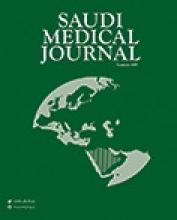Abstract
OBJECTIVE: To evaluate the role of the rapid influenza diagnostic test (RIDT) and clinical decision in the diagnosis of H1N1.
METHODS: In November 2009, 290 suspected influenza patients were examined for H1N1 during an outbreak in Riyadh, Saudi Arabia. Nasopharyngeal swabs were analyzed using Directigen EZ Flu A+B kit. Monoclonal anti-human influenza A/B and reverse transcription- polymerase chain reaction (RT-PCR) were used. Positive and negative controls were used in each run of specimens. Validity indices were calculated for RIDT and clinical diagnostic criteria.
RESULTS: The sensitivity and specificity of RIDT were 40.5% (95% confidence interval [CI]: 33.0-48.5), and 94.5% (95% CI: 88.6-97.6). The sensitivity of clinical decision was 66.3% (95% CI: 58.4-73.4), and the specificity was 65.4% (95% CI: 56.3-73.4). The sensitivity of clinical decision was higher in early presenters (79.2%; 95% CI: 57.3-92.1). The RIDT sensitivity was higher in younger patients (48.4%; 95% CI: 35.7-61.3). The positive predictive value (PPV) was 90.4% (95% CI: 80.7-95.7) for RIDT, and 71.1% (95% CI: 63.1-78.0) for clinical decision. The PPV for RIDT was greater for older (94.7%; 95% CI: 80.9-99.1) and late (90.7%; 95% CI: 76.9-97.0) presenters. The adjusted odds ratio for clinical decision was significant for cough, headache, and fatigue.
CONCLUSION: The RIDT can be useful in epidemics and high prevalence areas, whereas clinical decision, and RT-PCR complement the diagnosis of H1N1 in any setting.
- Copyright: © Saudi Medical Journal
This is an open-access article distributed under the terms of the Creative Commons Attribution-Noncommercial-Share Alike 3.0 Unported, which permits unrestricted use, distribution, and reproduction in any medium, provided the original work is properly cited.






